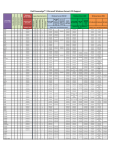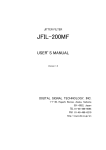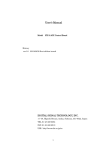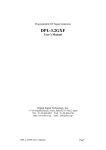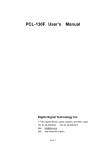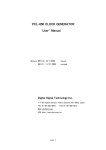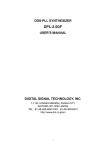Download PCV-50F FREQUENCY CONVERTER USER`S MANUAL DIGITAL
Transcript
PCV-50F FREQUENCY CONVERTER USER’S MANUAL History rev1.0 2/1/2003 first edition issued rev1.1 3/1/2003 consumption current revised rev1.2 3/1/2004 10M→REF revised DIGITAL SIGNAL TECHNOLOGY, INC. 1-7-30, Higashi Benzai, Asaka, Saitama, 351-0022, Japan TEL 81-48-468-6094 Email : [email protected] http://www.dst.co.jp/en 1 FAX 81-48-468-6210 1. Functional outline The PCV-50F is a programmable oscillator that can take out signals of desired frequencies from 1Hz to 50MHz with 0.001Hz resolution by using a 48-bit DDS (direct digital synthesizer). The external reference frequency can be input as desired in a range of 7MHz to 50MHz. The output frequency can have an accuracy based on the stability of the external reference signal. Frequency settings can be made with serial data and parallel data. 2. Specifications 2-1. Electrical specifications Power supply voltage +5V±5% Consumption current 500mA or less Output level CMOS Output frequency range 0.001Hz - 50MHz Frequency resolution 1mHz (0.001Hz) Output waveform duty 50%±5% Frequency error 0.46μHz or less with respect to external reference Jitter ±100pS rms or less (cycle-to-cycle jitter value at 5MHz or higher frequency) Spurious level 40dBc or more (excluding harmonics) External reference signal frequency 10MHz±5% External reference signal level 2 - 5Vp-p Duty 50±10% External reference input impedance 470Ω or more Frequency control Parallel input Six signal lines 4-bit BCD input 1-bit digit/data selection 1-bit reference/output frequency data selection 1-bit strobe signal Serial input 9600bps, 8 bits No parity, 1 stop bit Frequency setting time Within 250mS (Time between completion of setting of 2 frequency data and acquisition of the set frequency) Outer dimensions 61x46x13 (mm) 2-2. Environmental conditions Operating temperature range 0℃ - 50℃ 3. Outer dimensions 4. Pin assignments GND 1 +5V 2 PIN1 MARK 16 REF 17 GND 18 FOUT/REF GND SET 3 A/D 4 D0 5 D1 6 D2 7 D3 8 13 RXD 9 12 OUT TXD 10 11 GND (TOP VIEW) 3 5. Pin names and descriptions Pin No. Name Description 1 GND Power supply/signal GND. 2 +5V Power supply pin, to which +5V±5% should be supplied. 3 SET Strobe signal for setting with parallel data. As it is pulled up internally, data of A/D and D0 to D3 are read internally by connecting it to GND. Data is loaded on falling edge. 4 A/D Select digit or numerical value for parallel data D0 to D3. Set digit of 7-digit frequency data you want to change by H (open). Set the numerical value for selected digit by L (short-circuited to GND) It is pulled up internally. 5 D0 Input of frequency data digit or numerical data bit 0 (20). 6 D1 Input of frequency data digit or numerical data bit 1 (21). 7 D2 Input of frequency data digit or numerical data bit 2 (22). 8 D3 Input of frequency data digit or numerical data bit 3 (23). 9 RXD Asynchronous serial data input pin. Level is TTL-compatible CMOS. When not in use, open it because the input is pulled up. 10 TXD Asynchronous serial data output pin. Level is TTL-compatible CMOS. When not in use, open it. 11 GND Power supply/signal GND. 12 OUT Output terminal. 13 GND Power supply/signal GND. 14 FOUT/REF Input pin to select input of output frequency or reference signal frequency data for frequency setting in parallel: H (open) and L (short-circuited to GND) result in selection of output frequency and reference signal frequency, respectively. 15 GND Power supply/signal GND. 16 REF Desired external clock input. Remark: Pin No. 3, 4, 5, 6, 7, 8, 9, and 14 are pulled up by 10KΩ. 4 6. How to set frequencies with parallel data Setting data includes reference frequency and output frequency, either of which is determined by the FOUT/REF pin. 6-1. REF frequency setting The reference signal frequency can be set in units of 1 mHz. Since the maximum frequency of the reference signal is 50MHz, it is necessary to input frequency data at up to 11 digits by the following procedures. In the reference signal setting mode, set FOUT/REF to LOW level (short-circuited to GND). Next, select the digit to input, and then set the frequency data for that digit. Select whether the BCD SW corresponds to digit or frequency data by the A/D input. For example, how to set for inputting 16,000,000Hz is shown below. (a) Open S2, set the DIP SW to 0 (digit of 0.001Hz), and push S1 for inputting (short-circuited to GND). (b) Close S2 (short-circuited to GND), set the BCD SW to 0 (frequency data at the digit of 0.001Hz), and push S1. Now, frequency data is set at one digit. (c) Also, set at the digit of 0.01Hz as in (a) and (b) by setting the BCD SW to 1 (digit of 0.01Hz) and pushing S1 for digit setting. (d) In a similar manner, set the frequency data from the digit of 0.1Hz to the digit of 100KHz to 0. (e) At the digit of 1MHz, open S2, set the BCD SW to 9, push S1, and then close S2, set the BCD SW to 6, and push S1. (f) At the digit of 10MHz, open S1, set the BCD SW to A, push S1, and then close S2, set the BCD SW to 1, and push S1. (Remark) Since the input buffer of parallel data is initially set to “0” immediately after power-on, “0” data can be omitted. In the above example, (a) to (d) can be omitted. (Caution) Keep in mind that if the REF signal of a frequency higher than the set reference frequency is input, the consumption current will increase, and if this state is continued for a long time, the device may be damaged. 6-2. Output frequency setting The output frequency can also be set in units of 1 mHz. Since the maximum frequency of the output is 50MHz, it is necessary to input frequency data at up to 11 digits by the 5 following procedures. In the output frequency setting mode, set FOUT/REF to HIGH level (open). Next, select the digit to input, and then set the frequency data for that digit. Select whether the BCD SW corresponds to digit or frequency data by the A/D input. For example, the method of setting for inputting 43,000,000Hz is shown below. (a) Open S2, set the DIP SW to 0 (digit of 0.001Hz), and push S1 for inputting (short-circuit to GND). (b) Close S2 (short-circuited to GND), set the BCD SW to 0 (frequency data at the digit of 0.001Hz), and push S1. Now, frequency data is set at one digit. (c) Also, set at the digit of 0.01Hz as in (a) and (b) by setting the BCD SW to 1 (digit of 0.01Hz) and pushing S1 for digit setting. (d) In a similar manner, set the frequency data from the digit of 0.1Hz to the digit of 100KHz to 0. (e) At the digit of 1MHz, open S2, set the BCD SW to 9, push S1, and then close S2, set the BCD SW to 3, and push S1. (f) At the digit of 10MHz, open S1, set the BCD SW to A, push S1, and then close S2, set the BCD SW to 4, and push S1. 6-3. How to save frequency by parallel data For saving the set frequency in the built-in EEPROM semipermanently, open S2, set the BCD SW to E (10), and push S1. 6-4. Caution for setting data consecutively Since the PC performs frequency setting processing immediately after setting of frequency data, if settings are made continuously, this processing will not be performed in time. If you set one frequency, set a new frequency after a lapse of 200mS or more. (See the timing chart shown below.) >60ns >100ns A/D D0-D3 FOUT/REF >100ns SET >200ms Parallel data timing chart 6 Example of parallel data setting circuit +5V 1 GND 2 +5V REF 16 GND 15 14 FOUT/REF OPEN:FOUT SHORT:REF PCV-50 S1 3 SET S2 4 A/D 5 D0 6 D1 7 D2 8 D3 GND 13 9 RXD OUT 12 10 TXD GND 11 1 BCD 2 SW 4 8 COM BCD SWはコンプリメンタリー The BCD SW in use is the タイプを使用します complementary type. 7 S3 Function table A/D D3 D2 D1 L L L L L Frequency data 0 L L L L H Frequency data 1 L L L H L Frequency data 2 L L L H H Frequency data 3 L L H L L Frequency data 4 L L H L H Frequency data 5 L L H H L Frequency data 6 L L H H H Frequency data 7 L H L L L Frequency data 8 L H L L H Frequency data 9 H L L L L 0.001Hz digit setting H L L L H 0.01Hz digit setting H L L H L 0.1Hz digit setting H L L H H 1Hz digit setting H L H L L 10Hz digit setting H L H L H 100Hz digit setting H L H H L 1KHz digit setting H L H H H 10KHz digit setting H H L L L 100KHz digit setting H H L L H 1MHz digit setting H H L H L 10MHz digit setting H H H H L Frequency saving H: Open D0 Function L: Short-circuited to GND The input data of D0 to D3 and A/D are loaded on the falling edge of SET. For output frequency setting, set FOUT/REF to H (open), and for reference signal frequency setting, set it to LOW (short-circuited to GND). 7. Setting with serial data 7-1. Setting procedures At power-on, the following message appears. PCV50 FREQUENCY CONVERTER * 8 VX.X When the prompt “*” is returned from the PCV50F, frequency data can be input. If data is input properly, the prompt “*” is returned, and the input frequency is output. If the input frequency is invalid, “INVALID DATA” is returned. For setting the frequency consecutively, transmit frequency data, and confirm that the prompt “*” is returned, and then input next frequency data. The frequency can be input in MHz, KHz, Hz, or mHz (0.001Hz) together with a decimal point. For inputting the reference frequency, prepend the letter “R” to the frequency data. The following table shows an example of data for setting the reference frequency to 10.25MHz. R 1 0 ・ 2 5 52 31 30 2E 32 35 hex hex hex hex hex hex M CR 4D OD hex hex The following table shows an example setting of the output frequency. The data for setting an output frequency of 12.345678012MHz in MHz is shown below. 1 2 ・ 3 4 5 6 7 8 31 32 2E 33 34 35 36 37 hex hex hex hex hex hex hex hex 9 38 hex 0 1 2 M CR 39 30 31 32 4D OD hex hex hex hex hex hex The data for inputting the above frequency in mH is shown below. 1 2 3 4 5 6 7 8 31 32 33 34 35 36 37 38 hex hex hex hex hex hex hex hex 9 39 hex 0 1 2 m CR 30 31 32 6D OD hex hex hex hex hex 7-2. How to save frequency by serial data For saving the set frequency in the built-in EEPROM, transmit the “SAVE” command as shown below. If it is written properly, the message “EEPROM SAVED!” is returned. S A V E CR 53 hex 41 hex 56 hex 45 hex 0D hex 7-3. Level converter with RS-232C Since the level of PCV50F serial data is CMOS, such a level converter as shown below is required for use in connection with a PC serial port. 9 Example of serial data setting circuit 7-4. Caution for setting reference frequency In setting the reference frequency, if a frequency higher than the set reference frequency is added as the REF signal, the consumption current will increase significantly depending on the set value. If this state is left for a long time, the device may be damaged. Use the REF frequency and set value as properly adjusted. 8. Shipping inspection 8-1. Electrical inspection 100% inspection shall be performed for the electrical specifications in 2-1. 8-2. Appearance inspection Inspection shall be performed for contamination and bends in pins. 10 9. Other 9-1. In the event of any doubt arising about these specifications, discussion and resolution shall be made by arrangement. 9-2. This product, which employs a CMOS device, may be easily damaged by static electricity. 9-3. Keep in mind that immersion cleaning is not allowed. 9-4. Special damp proof control is not necessary. 10. Warranty If any defect is found due to the manufacturer’s improper production or design within one year after delivery, repair or replacement shall be performed at the manufacturer’s responsibility. ・ Descriptions in this manual are subject to change without notice. ・ No part of this manual may be reproduced without our permission. ・ We shall assume no liability for any user damage as a result of an accident, etc. ・ Descriptions in this manual shall not guarantee the practice of industrial property and other rights or grant a license for them. ・ We shall assume no liability for any third party’s industrial property rights attributable to the use of circuits, etc., described in this manual. Digital Signal Technology, Inc. 11












